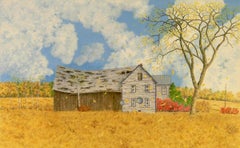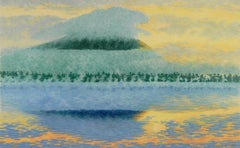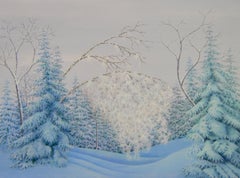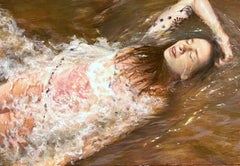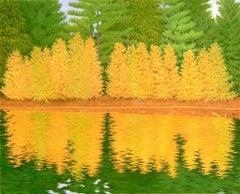Alan Bray Art
American, b. 1946
Alan Bray was born in Waterville, Maine, on January 12, 1946, but he grew up in Monson, a small slate-quarrying town set in the northern reaches of the Appalachians. It was here, hiking and camping with liked-minded childhood friends, that he began to exercise his natural inquisitiveness as a tool for building woods-craft. In these rugged foothills, ever alive with the turning of the seasons yet always plainly bearing the imprint of eons-old geologic upheaval, Bray learned to find his way around in a world of enigmatic signs and divergent trails. Unwittingly, before ever picking up a brush, he developed the sensibilities of a landscape painter by developing sensitivities to the relationships between the living and the ancient land on which life depends.
Later, when Bray decided to study art formally, he enrolled in the Art Institute of Boston, where he first felt the appeal of image-making as a way of understanding the world. Three years of studio work revealed the need for a more traditional approach to the discipline of painting, one informed by the broader range of a liberal education, a revelation that prompted Bray to enroll at the University of Southern Maine, from which he graduated in 1971. While this education was in many ways a success – particularly in the way it engendered literacies in fields outside the fine arts – it was nevertheless incomplete: well-prepared now for the next leg of the journey, Bray traveled to Florence to study at Villa Schifanoia Graduate School of Fine Arts.
Villa Schifanoia, Florence, the Italian Renaissance held many treasures and gave freely to a painter who was now mature enough in his art to receive them. Including a new medium and a new physical structure for his paintings –tempera on panel. The technical challenges of this medium, the necessary adjustments in craft, and the limitations of scale favored, and inspired, someone of a practical as well as a visionary intelligence.
Bray paints in casein, a milk-based tempera that has virtually no drying time. Necessarily, his paintings are technically complex because they consist of thousands of tiny brush strokes, built up in layers, out of which the images – the vision – advance from the foundation of a mirror-smooth, absolute void of white ground. It is a method of painting that follows directly from his method of exploring his subjects.to
1
2
5
Overall Width
to
Overall Height
to
7
2
5
1
1
6
5
4
3
2
1
1
1
1
1
1
1
1
1
1
1
1
1
1
6
6
6
5
1
7
8,227
2,805
1,654
1,312
5
7
Artist: Alan Bray
Fallow, Rustic Farmhouse Landscape Painting in Maine, Autumn Fields, Elm Tree
By Alan Bray
Located in New York, NY
As the artist states about this painting: "I first photographed this farm because it had one of the last living Elm trees in our area. Most began dying in the 70's and there are very...
Category
2010s American Realist Alan Bray Art
Materials
Casein, Panel
First Light, A Misty Morning Sunrise Scene in Maine with a Mountain View
By Alan Bray
Located in New York, NY
In First Light (2024), Alan Bray captures the quiet majesty of dawn over Spencer Pond, Maine. This luminous casein tempera on panel painting (15 x 24 inches) depicts a breathtaking s...
Category
2010s American Realist Alan Bray Art
Materials
Casein, Panel
Clearing Off, contemporary Impressionist casein landscape painting
By Alan Bray
Located in New York, NY
Alan Bray’s landscape paintings of his native, central Maine explore the ever-ebbing dynamic between nature and humanity. His paintings capture an asymmetrical pas de deux. Painted with uncompromising precision by his quick-drying casein tempera paint, Bray’s trailheads, shorelines, and vast horizons show evidence of previous human presence as it succumbs to natural growth.
Bray’s stylized scenes center on these afterimages of human interference as well as other natural phenomena. Inundated with detail, nature reclaims swaths of scarred land, fallen trees, and dilapidated structures, returning them to their wild form. Natural phenomena such as wild overgrowth, animal tracks, mysterious forms, bogs, and mist are resplendently captured as homage to the rugged and uninhabited corners of secluded Maine.
Alan Bray builds his landscapes with numerous layers of quick-drying casein tempera. Often used in Italian Renaissance painting...
Category
2010s American Impressionist Alan Bray Art
Materials
Casein, Panel
A Whisper Breaks the Silence, A Poetic Wintry Landscape with Soft Blue and White
By Alan Bray
Located in New York, NY
In A Whisper Breaks the Silence (2024), Alan Bray masterfully captures the quiet majesty of a deep winter forest in Maine. This luminous casein tempera on panel painting (15 x 20 inc...
Category
2010s American Realist Alan Bray Art
Materials
Casein, Panel
Neighbors Snowy branches, bird nests, gnome-like forms casein tempera painting
By Alan Bray
Located in New York, NY
Alan Bray’s Neighbors is a masterful casein tempera painting capturing the quiet beauty of winter. Delicate, snow-covered branches contrast against a crisp blue sky, while two bird n...
Category
2010s American Realist Alan Bray Art
Materials
Casein, Panel
Woodshed Spencer Pond Camps, a Black and White Drawing of a Wood Pile in Forest
By Alan Bray
Located in New York, NY
This original graphite drawing by Alan Bray captures a meticulously stacked woodshed in a tranquil forest setting. With fine detail and precision, Bray’s work evokes the quiet beauty...
Category
2010s American Realist Alan Bray Art
Materials
Archival Paper, Graphite
A Rise, blue and green casein on panel impressionist waterscape painting, 2004
By Alan Bray
Located in New York, NY
Bray has explored a smaller, more demure 8.5 x 11 inch format for two of these casein on panel paintings. When coupled with his rich palette and tightly hatched bed of brushstrokes, ...
Category
2010s American Impressionist Alan Bray Art
Materials
Casein
$7,200 Sale Price
20% Off
Related Items
"Mt. Evans and Bierstadt, Colorado" Oil Painting
Located in Denver, CO
David Shingler's (NC based) "Mt. Evans and Bierstadt, Colorado" is an oil painting that depicts a green grassy plain dotted with Pine trees leading to the snow capped mountains in th...
Category
2010s American Impressionist Alan Bray Art
Materials
Oil, Wood Panel
As the Days Wash Over Me Egg Tempera 12 x 24 Portraiture Finalist PSA
By E. Melinda Morrison
Located in Houston, TX
As the Days wash over Me‐ Egg Tempera ‐ Tempera Prepped Aluminum panel ‐ 12 x 24 is by E. Melinda Morrison who lives in Fort Worth Texas. Also posted are other paintings available b...
Category
2010s American Impressionist Alan Bray Art
Materials
Egg Tempera
$2,700
H 12 in W 24 in D 1 in
"Eastern Plains of Colorado" By Sparky LeBold, Colorado Landscape Oil Painting
Located in Denver, CO
"Eastern Plains of Colorado" by Sparky LeBold (US and Portugal based) is a beautiful handmade oil painting that depicts a view of the vast green plains of Colorado, with the famed su...
Category
2010s American Impressionist Alan Bray Art
Materials
Oil, Panel
News From a Faraway Land, Original Drawing, Interior Scene, Vase, flowers
Located in AIX-EN-PROVENCE, FR
Work : Original Drawing, Handmade Artwork, Unique Work. The work has been treated with an anti-UV varnish and it is not framed.
Medium : Oil based color pencils on Hahnemühle Fine A...
Category
21st Century and Contemporary Contemporary Alan Bray Art
Materials
Oil Crayon, Archival Paper, Color Pencil
$477
H 10.24 in W 7.88 in D 0.12 in
"As you Wish" Oil Painting
Located in Denver, CO
Clyde Steadman's "As you Wish" is an original, handmade oil painting that depicts an impasto painting of a bison in profile.
Category
2010s American Impressionist Alan Bray Art
Materials
Oil, Panel
Old House, Built in 1848
By Gilbert Neumann
Located in Austin, TX
"Old House, Built in 1848" by painter Gilbert F. Neumann
Medium: Oil paint on panel
Size: 9 x 12 inches
Frame Size: 14 x 18.5 inches
A nostalgic painting of ...
Category
20th Century American Impressionist Alan Bray Art
Materials
Oil, Panel
Once The Master - Mid Century Figurative Landscape
By Benjamin G. Vaganov
Located in Soquel, CA
Once The Master - Mid Century Figurative Landscape
"Once the Master" a portrait of a Zuni Master Potter in contrast with the emergent modernism around him. He is beneath an adobe an...
Category
1950s American Impressionist Alan Bray Art
Materials
Linen, Egg Tempera, Cardboard
$2,120 Sale Price
20% Off
H 27.5 in W 24.5 in D 2 in
"June Evening" oil painting, sunlit landscape with tree, a view of water, framed
By Kelly Carmody
Located in Sag Harbor, NY
An oil painting of two trees basking in the summer's golden sun. The sea can be seen in the distance, just beneath the horizon. The sky is a soft blue with a streak of grey clouds.
...
Category
21st Century and Contemporary American Impressionist Alan Bray Art
Materials
Oil, Panel
Fishing for Breakfast 8" x 10" Gouache on Illustrated Board Renaissance Wax
By E. Melinda Morrison
Located in Houston, TX
Fishing for Breakfast 8" x 10" Gouache on Illustrated Board Finished with Renaissance Wax
Gouache (/ɡuˈɑːʃ, ɡwɑːʃ/; French: [ɡwaʃ]), body color,[a] or opaque watercolor is a wat...
Category
2010s American Impressionist Alan Bray Art
Materials
Egg Tempera, Panel
E. Melinda MorrisonFishing for Breakfast 8" x 10" Gouache on Illustrated Board Renaissance Wax, 2024
$650
H 8 in W 10 in D 1 in
Street Riot Oil Painting Mounted Police WPA artist Social Justice Americana Art
By Arthur Smith
Located in Surfside, FL
Riot, Revolution, Police figures on Horseback in City Streets.
Hand signed lower right.
Painting measures 6 x 12, framed 9 x 15 inches.
Arthur Smith is a listed American painter mos...
Category
Mid-20th Century American Realist Alan Bray Art
Materials
Oil, Panel
Maine Morning
Located in Wilton Manors, FL
Beautiful winter landscape by American artist, J. Philip Richards (1906-1991). Maine Morning, 1974. Casein on paper, 16 x 26 inches; 26 x 36 inches framed. Signed lower right. Signed, titled and dated on verso. Excellent condition.
Born in Moosic, PA, and graduated from the College of Fine Arts of Syracuse University in New York, J Philip Richards worked and studied with such artists of international reputation as William Von Schlagell, James Fitzgerald, David Porter, and John Taylor.He was professor emeritus of Fine Arts at Wilkes College in Wilkes-Barre, PA. Member of the American Watercolor Society, NYC, NY; York Artists Association, York, ME; Ogunquit Art Association, Ogunquit, ME; Wyoming Valley Art League, Wilkes-Barre, PA; National Society of Casein Painters, NYC, NY; Director Ancestor's Art Workshops, Searsport, ME; Gallery Director, "Gallery 164," Kennebunk, ME; Professional Artists League of America, NYC, NY; Art Guild of Kennebunks, Kennebunk, ME; Maine Artists...
Category
1970s Impressionist Alan Bray Art
Materials
Casein
"Misty City", Oil Painting
By Christopher Clark
Located in Denver, CO
Christopher Clark's (US based) "Misty City" is an original, handmade oil painting that depicts orange and green hued clouds arching over a water and city lights
Bio/artist statement:
Christopher has been an artist since early childhood, when he would watch Bob Ross on PBS and mimic the famed oil painter’s art with crayons. He considers himself a self-educated artist, with his studies ranging from personal training with contemporary masters, to classical academic art technique, with much inspiration from 19th Century art and the Impressionist Movement. Christopher lived in Italy for a time, immersing himself in Italian culture and art, which continues to influence his painting. His fan base has grown considerably since his return to the US, gaining the attention of Lucasfilm and Marvel Fine Art, which both signed him as an officially licensed artist in 2016. Other clients include George Lucas, Major League Baseball, Louisville Slugger...
Category
2010s American Realist Alan Bray Art
Materials
Canvas, Oil, Panel
Previously Available Items
Larch, Golden Trees Reflected in Lake with Pine Forest in Autumn Light
By Alan Bray
Located in New York, NY
Golden larch trees, autumn reflections, and tranquil forest lakes—this luminous painting captures a fleeting moment in nature with remarkable clarity and emotional depth. The golden ...
Category
2010s American Realist Alan Bray Art
Materials
Casein, Panel
H 16 in W 20 in D 2 in
Trails, casein on panel impressionist Maine winter landscape, 2020
By Alan Bray
Located in New York, NY
An homage to the Appalachian Trail, Bray’s latest deep-winter scene considers the difference between human intent and animal instinct. White blazed t...
Category
2010s American Impressionist Alan Bray Art
Materials
Casein, Panel
Sentinel, green and pink casein on panel impressionist landscape painting, 2020
By Alan Bray
Located in New York, NY
In Sentinel, Alan Bray’s layers of casein marks appear to emerge from beneath the space of the panel - the forest haze seeping up rather than resting upon the surface. The sentinel, ...
Category
2010s American Impressionist Alan Bray Art
Materials
Casein, Panel
Spring House, Impressionist casein Maine winter landscape painting, 2018
By Alan Bray
Located in New York, NY
Bray has explored a smaller, more demure 8.5 x 11 inch format for two of these casein on panel paintings. When coupled with his rich palette and tightly hatched bed of brushstrokes, ...
Category
2010s Impressionist Alan Bray Art
Materials
Casein, Panel
Alan Bray, Abandoned Spring, Casein on panel landscape painting, 2018
By Alan Bray
Located in New York, NY
In this casein on panel painting, Abandoned Spring, Alan Bray depicts the lush inner landscape of his native Maine. Bray uses his quick-drying paint to great effect, defining the spidery, tendril-like fingers of the emerald foliage as they overtake the water. The artist's paintings combine a sense of discovery with the meditative maturity of the Italian Renaissance masters. Bray also imposes a strangeness and a sense of place with rhythmic craggy, bent or curved natural objects painted as though from a dream state. "The way his uncanny narratives lean away from the rational," writes art critic Daniel Kany, "Bray is like the Edward Gorey of Maine landscape painting...
Category
2010s American Impressionist Alan Bray Art
Materials
Casein, Panel
H 19.75 in W 19.75 in D 2.25 in
Alan Bray, Clearcut with Wildlife Trees, Casein landscape painting, 2015
By Alan Bray
Located in New York, NY
Alan Bray paints landscape scenes in his native Maine using casein tempera paint on wood panel. Bray is fascinated by man-made structures in the wilderness disintegrating as the land...
Category
2010s Contemporary Alan Bray Art
Materials
Casein, Panel
Alan Bray, Hillside, Casein on panel landscape painting, 2016
By Alan Bray
Located in New York, NY
Alan Bray paints landscape scenes in his native Maine using casein tempera paint on wood panel. Bray is fascinated by man-made structures in the wilderness disintegrating as the land...
Category
2010s Contemporary Alan Bray Art
Materials
Casein, Panel, Wood Panel
Corduroy Road
By Alan Bray
Located in New York, NY
These kinds of woods roads are called Corduroy roads, laid down to traverse wet spots and boggy places. I came across this one in a large stand of Tamarack, which shed their needles ...
Category
2010s Contemporary Alan Bray Art
Materials
Casein, Panel
Alan Bray, Ghost, landscape lithograph on Rives BFK, 2012
By Alan Bray
Located in New York, NY
In "Ghost," the remnants of an old farmhouse foundation, now grown over with small trees and patchy grasses shows the endurance and indifference of nature; standing in mute testimony...
Category
2010s Contemporary Alan Bray Art
Materials
Archival Paper, Lithograph
Wet Spot
By Alan Bray
Located in New York, NY
Alan Bray captures a winter sunset landscape scene with wheat fields and a stream near his home in Maine. The mirror-smooth surface of the water, contrasting with the water in other ...
Category
21st Century and Contemporary American Realist Alan Bray Art
Materials
Casein, Wood Panel
Drowned Forest, Casein Tempera on Panel, Landscape Painting
By Alan Bray
Located in New York, NY
In Drowned Forest, 2014, a group of gray, gnarly tree stumps, some hosting green plants living within them, are in the midst of silver water spanning the entire picture plane. In the...
Category
21st Century and Contemporary American Realist Alan Bray Art
Materials
Casein, Wood Panel
Alan Bray, Four Things in the Wind, charcoal and conte landscape drawing, 2015
By Alan Bray
Located in New York, NY
In Four Things in the Wind, Bray draws in charcoal and Conté crayon to create the shore of a river on a windy day. The artist utilizes his bendy, rhythmic style to animate the eleme...
Category
21st Century and Contemporary American Realist Alan Bray Art
Materials
Conté, Charcoal, Archival Paper
Alan Bray art for sale on 1stDibs.
Find a wide variety of authentic Alan Bray art available for sale on 1stDibs. If you’re browsing the collection of art to introduce a pop of color in a neutral corner of your living room or bedroom, you can find work that includes elements of blue and other colors. You can also browse by medium to find art by Alan Bray in casein paint, paint, tempera and more. Much of the original work by this artist or collective was created during the 21st century and contemporary and is mostly associated with the Impressionist style. Not every interior allows for large Alan Bray art, so small editions measuring 18 inches across are available. Customers who are interested in this artist might also find the work of Samuel Hyde Harris, Stephen Motyka, and Edward Henry Potthast. Alan Bray art prices can differ depending upon medium, time period and other attributes. On 1stDibs, the price for these items starts at $7,200 and tops out at $12,000, while the average work can sell for $11,000.
